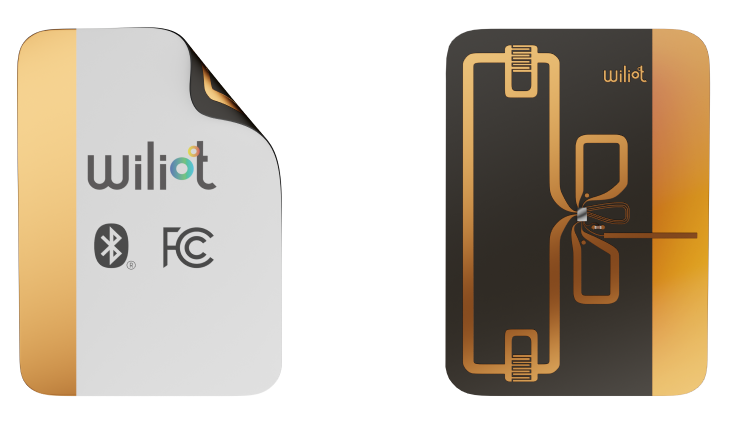An evolution of the traditional Internet of Things (IoT) technology, ambient IoT can provide businesses with real time data to enable them to make better supply chain and food safety decisions.
“The ‘ambient’ in ambient IoT comes from the fact that it is powered by radio waves that exist all around us,” explained Steve Statler, CMO at Wiliot. “The Internet of Things as we know it today has embedded intelligence into expensive things, like homes, cars, and smartphones. The ambient IoT aims to extend that intelligence to every single thing – meaning fruits, veggies, vaccine vials, cheese, milk, and crates.”
“Previously, IoT was like taking readings in the dark with a battery powered flashlight. Ambient IoT turns the lights on everywhere so that everything is always visible.” – Steve Statler, Wiliot
So, how does it work? Wiliot has developed IoT Pixels, which are stamp-sized compute devices powered by radio waves instead of batteries. The Pixels have a practically limitless lifespan and can be embedded in various objects, such as food product labels. They are essentially stickers that sandwich a miniature chip along with a harvesting and transmission anten and several other components between two layers of adhesive. can be produces at scale at a low cost thanks to the lack of battery. Since it’s powered by radio waves (such as those emitted by Bluetooth-enabled smartphones) and not a battery, the Pixels cost between 10c-75c to manufacture and can operate at very cold (-40°C) or hot environments (85°C). The sensing data is transmitted to the Wiliot Cloud, where it can be accessed by the user – whether the retailer, manufacturer or the consumer.
Wiliot, one of very few companies currently operating in the ambient IoT space, has been adding new sensing capabilities to its product, the latest being humidity sensing. “As the tag needs to be able to be manufactured in very high volumes, with each new capability we add, our goal is for the construction to remain simple, as any extra steps in manufacturing generate extra expense,” Statler told us. “In this case, the process of making a humidity sensor is relatively easy – the difficulty comes from making one that can be manufactured at a high volume for a very low cost.”

He added that the chip itself – which is secured with military-grade 128-but AES encryption and contains a 32-bit ARM Cortex M0 CPU – hasn’t changed that much over time. “We like to think of it like a Tesla update, where new capabilities come from software and design. In this case, the humidity sensing capability comes from an update to the cloud software and to the tag that acts as the carrier for the Wiliot IoT Pixels’ chip,” Statler explained. “For our newest update, engineers added a humidity sensing membrane to the carrier. One of the biggest changes we are making is to the cloud software that translates the values streaming from the tag. With the newest tag, they can calibrate the low level values coming from the tag and turn it into useful humidity readings.”
Asked about how this new sensing capability would affect pricing, he said the company aims for that additional cost to be ‘negligible’. “Our ability to do this rests on the central Wiliot invention, which enables postage stamp-sized, battery-free Bluetooth compute devices to operate ubiquitously. We want to create Internet of Things technology that is so low cost that it can be a part of every single thing.” Currently, the humidity sensing chip cost starts at 12c and goes up to 75c, just 2c more than the traditional chip in terms of the starting price.
So how does humidity sensing work in practice? “To add humidity sensing to the Wiliot platform, our engineers added a tiny membrane to IoT Pixels that detects humidity in the air,” Statler told us. “As IoT Pixels are exposed to changes in humidity levels throughout the supply chain, the electrical properties of the membrane fluctuate.”
The Pixels can detect changes in these properties via tiny connectors that link the chip to the membrane, we were told, and those changes are quantified and corresponding data values are uploaded to the cloud.
“Wiliot’s Visibility Platform then processes these changes and turns them into a Relative Humidity value,” Statler added. “The information in the Wiliot Visibility Platform is then available to users though apps, where they can see live data of humidity levels, along with all of the information that previous iterations of our IoT Pixels provided: temperature, location, carbon footprint, and more.
“The humidity reading is incredibly accurate, with a margin of error within 20%.”
Food producers, particularly those whose produce is sensitive to humidity and temperature fluctuations, can benefit significantly from this type of technological development, we were told. “Milk, cheese, yogurt, along with most other dairy products, are all not only temperature but humidity sensitive, meaning they can fall prey to mould or spore development quickly,” Statler said. “Beyond food safety, humidity can affect the taste and texture of food. For specialty cheeses, yogurts, and more that tend to be a splurge for consumers, they want peace of mind that their food will taste as it’s intended.
“For dairy producers looking to ship globally, assurance that their products will taste the same across the ocean is a major benefit.”
While the idea of transparency can be appealing to manufacturers seeking maximum traceability down the supply chain, is that level of scrutiny equally welcomed by stockists and distributors alike? Statler says that everyone in the supply chain can draw benefits and that the tech has been developed with privacy in mind. “Transparency is a force for good, and transparency is what IoT Pixels provides. The increasing food safety regulations agree with this point, as most will require food providers to monitor the transport and storage environment of their products closely.
“IoT Pixels were developed with privacy in mind. All information in the chip we developed is encrypted and translated by the Wiliot cloud and Visibility Platform, so the number of people with access to this data is limited. Additionally, we have pledged to never use the data received for advertising.”
The platform can also be leveraged by the end-consumer as a way to offer detailed info on a product’s carbon footprint, for example. “Currently, it’s up to retailers to decide whether or not to share that information with consumers,” Statler told us. “If a food producer does decide to showcase their results to this technology, it could be a major selling point.

“Imagine deciding between two cartons of ice cream. If one ice cream brand showcased next to the price tag a tag that certifies the ice cream was kept at freezing temperatures in a humidity-controlled environment during the entire shipping process, most consumers would gravitate towards that peace of mind.”
So far, Wiliot has worked with several leading retailers, with the Pixels being affixed to the reusable transport items (RTIs) used to transport produce from stores to customer’s homes.
“With real-time intelligence for thousands of RTIs, the retailer is able to achieve timely delivery and significantly reduce shrinkage. Previously, over half of these units were lost, causing an unacceptable cost burden on the home delivery system,” Statler explained. “With the Wiliot IoT platform, the retailer can track the real-time location of the RTIs, and last seen location. With this visibility, waste is rapidly and dramatically reduced, with the added benefit of having the status of last mile delivery in real time.”
In another example, Statler revealed that the company recently worked with a major retailer tracking crates of strawberries from distributor to truck, to store. “Those who were monitoring the data could see down to the individual case if the strawberries were being transported quickly and at a safe temperature,” he said.
There are other benefits versus traditional asset management systems, Statler added. “Wiliot IoT Pixels eliminates both human error and labor costs. Previous asset management technologies require humans to check in data at stops along the way, meaning there is always a risk of missteps, whereas the ambient IoT allows for constant tracking, saving not just money but time as well.”
This article has been edited to correct that the humidity sensor's margin of error is within 20% instead of 10% as originally stated.

